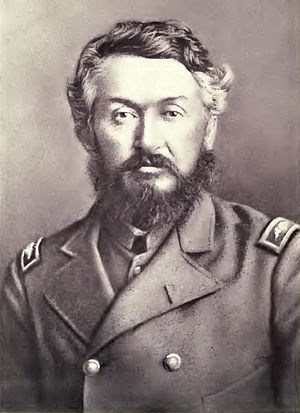Robert A. Hardaway facts for kids
Quick facts for kids
Robert Archelaus Hardaway
|
|
|---|---|

Robert Archelaus Hardaway
|
|
| Born | February 2, 1829 Georgia |
| Died | April 27, 1899 (aged 70) Columbus, Muscogee County, Georgia |
| Allegiance | |
| Service/ |
|
| Years of service | 1861–65 (CSA) |
| Rank | |
| Unit | Army of Northern Virginia |
| Battles/wars | American Civil War |
Robert Archelaus Hardaway (born February 2, 1829 – died April 27, 1899) was an important artillery officer. He served in the Confederate Army of Northern Virginia during the American Civil War.
Contents
Robert Hardaway's Early Life
Robert Archelaus Hardaway was born in Georgia on February 2, 1829. He grew up in Alabama. His parents were Robert Stanfield Hardaway and Martha Bibb Jarratt.
Robert went to school at St. Joseph's College in Alabama. He also studied at Emory College in Georgia, which is now Emory University.
Military Service Before the Civil War
Hardaway joined the United States Army during the Mexican War. However, the war ended before he could fight in any battles.
After the war, he worked as a superintendent for the Mobile and Girard Railroad. He lived in Macon County, Alabama. In 1857, he bought his father's large farm. That same year, on June 27, he married Rebecca Elizabeth Hurt. They had three sons together.
Robert Hardaway's Role in the Civil War
The American Civil War began in 1861. Robert Hardaway started his service as the leader of an artillery unit from Alabama. This unit was made up of soldiers mostly from Macon, Russell, and Tallapoosa counties.
Early Battles and Recognition
Hardaway's unit was sent East and officially joined the Confederate army on June 21, 1861. They were stationed at Manassas, Virginia, until March 1862.
His unit then moved to the Virginia Peninsula. They fought in the Battle of Seven Pines as part of Major General D. H. Hill's division. Hardaway's battery also took part in the Seven Days Battles.
After these battles, Hill's division stayed near Richmond, Virginia. Later, they left to join the Maryland Campaign. Hardaway was praised by Confederate leaders for how well his unit performed during this campaign.
Key Actions and Promotions
Later in 1862, Hardaway's gunners were near Fredericksburg, Virginia. On December 4, 1862, they used a special Whitworth gun to drive away Union gunboats from Port Royal, Virginia. Both General Hill and General Stonewall Jackson commended Hardaway for his actions at the Battle of Fredericksburg.
Soon after, Hardaway was given command of an artillery battalion. Captain William B. Hurt took over Hardaway's original unit. Hardaway was promoted to major on December 2, 1862. He was promoted again to lieutenant colonel on February 27, 1864.
Some officers, like Colonel Stapleton Crutchfield, thought Hardaway was a great gunner but too tough on his men and horses. Despite this, his promotion went through.
Battles and Campaigns
As a major, Hardaway became second-in-command of Lieutenant Colonel John J. Garnett's artillery battalion. This battalion was part of Major General Robert H. Anderson's division. They fought at the Battle of Chancellorsville under the direct command of General Robert E. Lee.
General Lee asked Hardaway to gather a group of special rifled guns. These guns were used to bombard Union camps on the morning of May 4, 1863.
Hardaway became sick with dysentery and missed the Gettysburg Campaign. He returned to duty in time for the Mine Run Campaign in the fall of 1863.
In the Battle of the Wilderness, Hardaway commanded his battalion. They were part of Lieutenant General Richard S. Ewell's corps. His battalion stayed with this corps throughout the Overland Campaign.
At the Battle of Spotsylvania Court House, Hardaway's guns were in the second line of Ewell's corps. Some of them were moved forward to help stop a Union breakthrough on May 11.
When the corps, led by Jubal Early, left to defend Lynchburg, Virginia, Hardaway's battalion stayed behind. They were assigned to defend Richmond, Virginia, reporting to Brigadier General Edward Porter Alexander. The battalion played a role in the Battle of Chaffin's Farm and spent much of late 1864 defending Chaffin's Bluff.
End of the War
The corps that Ewell and Early had led later returned to defend Petersburg, Virginia. Major General John B. Gordon was now its commander. Hardaway's battalion rejoined this corps.
Hardaway's gunners served under Gordon in the Appomattox Campaign. They fired one of the very last shots before General Lee surrendered. Hardaway was released from service on May 10, 1865.
Life After the Civil War
After the war, Robert Hardaway went back to his farm in Georgia. He then returned to working with railroads. From 1869 to 1872, he was the general manager of the East Alabama Railroad.
Hardaway became a professor of engineering at Auburn University from 1873 to 1881. He then worked as an engineer for the Central Railroad in Mexico in 1881 and 1882. After that, he taught at the University of Alabama from 1882 to 1897.
Robert Hardaway passed away on April 27, 1899, in Columbus, Georgia. Hardaway Hall at the University of Alabama, built in 1936, was named in his honor.

